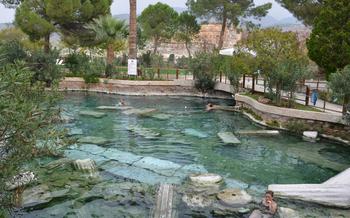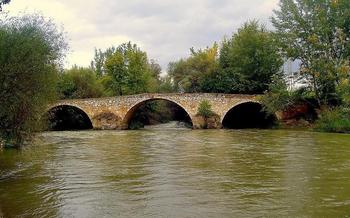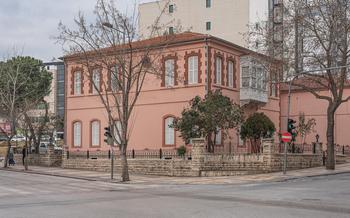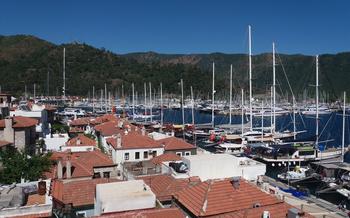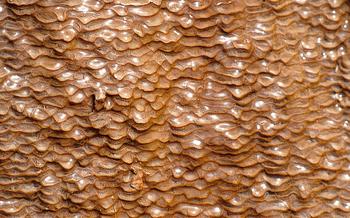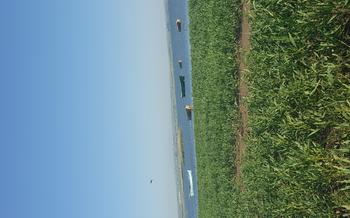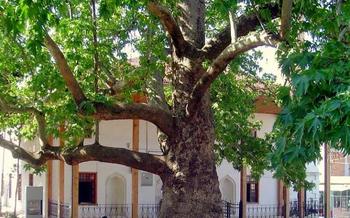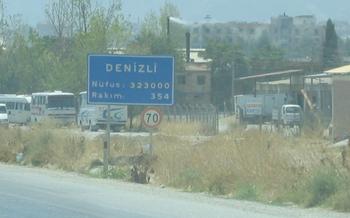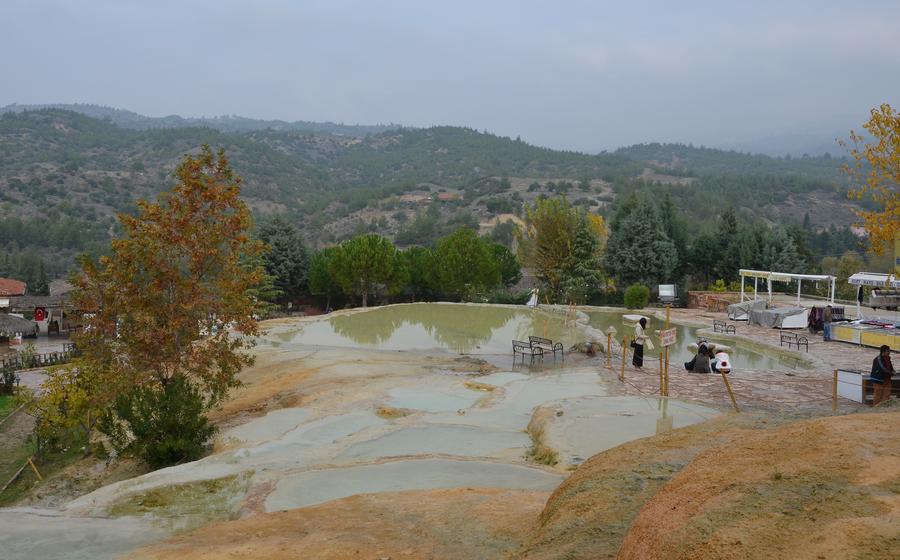
Pamukkale Thermal Pools
- Pamukkale Thermal Pools: A Natural Wonder
- History and Legends of Pamukkale
- Visiting Pamukkale: What to Expect
- Exploring the Travertine Terraces
- Hierapolis Ancient City
- Cleopatra's Pool: A Relaxing Experience
- Mud Baths and Wellness Treatments
- Hot Air Balloon Rides Over Pamukkale: A Unique Perspective
- Where to Stay in Pamukkale
- Where to Eat in Pamukkale
- Shopping in Pamukkale: Discovering Local Treasures
- Getting to Pamukkale: Unveiling the Gateway to Natural Wonders
- Tours and Guided Visits
- Tips for Photography Enthusiasts
- Insider Tip: Secret Spot for Panoramic Views
Pamukkale Thermal Pools: A Natural Wonder
The Pamukkale Thermal Pools, a natural wonder located in Denizli, Turkey, are a sight to behold. The unique landscape, characterized by cascading travertine terraces, has earned it the title of "Cotton Castle" and a spot on the UNESCO World Heritage List.
These thermal pools were formed over thousands of years by the deposition of calcium carbonate from the hot springs that flow down the mountainside. The travertine terraces, with their cascading pools of turquoise water, create a stunning and awe-inspiring spectacle. The warm, mineral-rich waters of the pools are believed to have healing properties, attracting visitors from all over the world seeking rejuvenation and relaxation.
The Pamukkale Thermal Pools are a true natural wonder, offering visitors a unique and unforgettable experience. Whether you're interested in history, geology, or simply seeking a relaxing and rejuvenating getaway, Pamukkale is a must-visit destination.
History and Legends of Pamukkale
Pamukkale's unique landscape has attracted visitors for centuries, leaving behind a rich tapestry of history and legends. The ancient city of Hierapolis, founded in the 2nd century BC, once stood atop the travertine terraces, thriving as a center of trade and healing. Its well-preserved Roman ruins, including an impressive amphitheater, colonnaded streets, and intricate temples, offer a glimpse into the grandeur of the past.
A prominent feature of Hierapolis is the iconic Cleopatra's Pool, an ancient thermal pool believed to have been frequented by the Egyptian queen herself. Constructed in the 2nd century AD, this well-preserved pool boasts warm, mineral-rich waters said to possess rejuvenating properties. Visitors can immerse themselves in its soothing embrace and imagine themselves transported back in time.
Legends abound regarding the healing powers of Pamukkale's thermal waters. It is said that the springs were discovered by a shepherd who noticed his sheep miraculously cured of skin ailments after bathing in the mineral-rich pools. Since then, people from all walks of life have sought relief from various health conditions by immersing themselves in these therapeutic waters, believing in their restorative abilities.
Visiting Pamukkale: What to Expect
Prepare yourself for a unique and memorable experience when visiting Pamukkale. However, to make the most of your trip, it's essential to be aware of several factors that can impact your visit.
Crowds: Pamukkale is a popular tourist destination, so be prepared for crowds, especially during the summer months. To avoid the hustle and bustle, consider visiting during the shoulder seasons (spring and fall) or on weekdays.
Weather conditions: The weather in Pamukkale can be hot and dry during the summer months, with temperatures reaching up to 40 degrees Celsius. It's crucial to stay hydrated and wear sunscreen to protect yourself from the sun. In the winter, temperatures can drop significantly, so bring warm clothing.
Entrance fees: There is an entrance fee to visit Pamukkale. The current fee for international visitors is 110 TL (Turkish Lira), which includes access to the travertine terraces, the ancient city of Hierapolis, and Cleopatra's Pool.
Facilities: Pamukkale offers various facilities for visitors, including restaurants, cafes, souvenir shops, and toilets. However, it's essential to note that the site is vast, and some areas may not be easily accessible for those with mobility issues.
By being prepared for these factors, you can ensure a smooth and enjoyable visit to this natural wonder.
Exploring the Travertine Terraces
Roam barefoot across the smooth, milky-white travertine terraces, feeling the gentle warmth beneath your soles. The unique composition of the mineral-rich water has created a surreal landscape of cascading pools and stepped terraces, resembling a natural staircase leading to the heavens.
Capture the breathtaking beauty of the travertines with your camera, ensuring you capture the stunning contrast between the brilliant white terraces and the azure waters. The best time for photography is during the golden hours of sunrise and sunset, when the soft light casts a magical glow across the landscape.
Immerse yourself in the therapeutic waters of the shallow pools, letting the warm, mineral-rich water soothe your body and mind. Experience the ultimate relaxation as you float effortlessly, surrounded by the ethereal beauty of Pamukkale.
While enjoying the travertines, remember to respect the fragile ecosystem that sustains this natural wonder. Refrain from using harsh chemicals or soaps, as they can damage the delicate travertine formations. Together, we can preserve the pristine beauty of Pamukkale for generations to come.
Hierapolis Ancient City
Amidst the ethereal beauty of Pamukkale's travertine terraces, the ancient city of Hierapolis stands as a testament to the region's rich history and cultural heritage. Founded in the 2nd century BC by the Seleucid king Eumenes II, Hierapolis flourished as a thriving spa town, attracting visitors from across the Roman Empire who sought to bathe in its healing thermal waters.
Explore the well-preserved Roman ruins, including the impressive amphitheater, which could accommodate up to 12,000 spectators and hosted gladiatorial contests and theatrical performances. Marvel at the intricate carvings and inscriptions adorning the theater's facade, offering glimpses into the artistry and craftsmanship of the ancient world.
Stroll through the sprawling necropolis, where elaborate sarcophagi and tombs line the ancient streets, providing a glimpse into the funerary practices and beliefs of Hierapolis' inhabitants. Discover the Agora, the bustling marketplace where traders from across the region gathered to exchange goods and socialize.
Immerse yourself in the history and culture of Hierapolis, a city that has witnessed the rise and fall of civilizations, and whose ruins stand as a testament to the enduring legacy of the ancient world.
Cleopatra's Pool: A Relaxing Experience
Amidst the natural wonders of Pamukkale, Cleopatra's Pool stands as an ancient oasis of tranquility and rejuvenation. This historic pool, named after the legendary Egyptian queen, is a testament to the region's rich history and therapeutic allure.
Cleopatra's Pool is a naturally formed pool filled with warm, mineral-rich waters that have been renowned for their healing properties since ancient times. Legend has it that Cleopatra herself frequented this pool to maintain her famed beauty and youthfulness.
Visitors to Pamukkale can immerse themselves in the warm, soothing waters of Cleopatra's Pool, surrounded by the stunning travertine terraces. The pool offers a unique and relaxing experience, allowing visitors to unwind and let their worries melt away.
In addition to its therapeutic benefits, Cleopatra's Pool is also a popular spot for sunbathing and relaxation. Visitors can bask in the warm Turkish sun while enjoying the picturesque views of the surrounding landscape.
For those seeking a truly indulgent experience, massage services are available at the poolside. Skilled therapists offer a variety of massage techniques to soothe tired muscles and promote deep relaxation.
Whether you're looking to rejuvenate your body and mind, soak up the sun, or simply enjoy the beauty of your surroundings, Cleopatra's Pool offers an unforgettable experience that should not be missed.
Mud Baths and Wellness Treatments
Pamukkale offers a unique opportunity to experience the therapeutic benefits of mud baths. The mud, rich in minerals and nutrients, is believed to have healing properties for skin conditions, joint pain, and other ailments. Visitors can indulge in a mud bath at one of the many spas in the area. The process typically involves applying a layer of mud to the body, letting it dry, and then rinsing it off with warm water.
The mud baths in Pamukkale are a great way to relax and rejuvenate. The mud's warmth and minerals help to soothe muscles, improve circulation, and detoxify the body. The mud also has exfoliating properties, leaving the skin feeling soft and smooth.
In addition to mud baths, visitors can also enjoy a variety of other wellness treatments in Pamukkale. These include massages, facials, and body wraps. The treatments are designed to promote relaxation and well-being, and they can be tailored to individual needs.
Whether you are looking to relieve pain, improve your skin, or simply relax and rejuvenate, Pamukkale's mud baths and wellness treatments are a must-try.
Hot Air Balloon Rides Over Pamukkale: A Unique Perspective
Pamukkale's surreal landscape is even more breathtaking from above. Hot air balloon rides offer a unique opportunity to witness the cotton-like travertine terraces, the ancient ruins of Hierapolis, and the surrounding countryside from a bird's-eye view.
Gliding silently over the Pamukkale valley at sunrise is an unforgettable experience. The warm glow of the rising sun illuminates the landscape, casting long shadows and creating a magical atmosphere. The colors are vibrant, the air is crisp, and the views are simply stunning.
Hot air balloon rides typically last for about an hour, providing ample time to take in the scenery and capture some incredible photographs. The balloons are operated by experienced pilots who ensure a smooth and safe flight.
For photography enthusiasts, a hot air balloon ride over Pamukkale is a must-do. The unique perspective allows for breathtaking shots of the travertine terraces, the ancient ruins, and the surrounding mountains.
Whether you're a photographer, a nature lover, or simply seeking a once-in-a-lifetime experience, a hot air balloon ride over Pamukkale is an adventure you won't soon forget.
Where to Stay in Pamukkale
Pamukkale offers a range of accommodation options to suit different budgets and preferences. From luxurious hotels and resorts to budget-friendly guesthouses, there's something for every traveler.
High-End Hotels and Resorts:
For those seeking a lavish stay, Pamukkale boasts several upscale hotels and resorts. These properties offer elegant rooms and suites, often with private balconies or terraces overlooking the travertine terraces or the ancient city of Hierapolis. Guests can indulge in world-class amenities such as spas, swimming pools, and fine dining restaurants.
Mid-Range Hotels:
For a comfortable and convenient stay, mid-range hotels in Pamukkale provide a good balance of quality and affordability. These hotels typically offer clean and well-equipped rooms, as well as basic amenities like room service, laundry facilities, and breakfast.
Budget Options:
Budget travelers can find a variety of hostels, guesthouses, and pensions in Pamukkale. These accommodations offer simple but comfortable rooms at an affordable price. Some budget options also include shared facilities such as kitchens and common areas, allowing travelers to socialize and save money on meals.
Location Considerations:
When choosing a place to stay in Pamukkale, consider the location carefully. If you're primarily interested in exploring the travertine terraces and Hierapolis, it's best to stay in a hotel or guesthouse within walking distance of these attractions. For those who prefer a more relaxed stay, hotels located in the countryside or on the outskirts of town offer tranquility and stunning views.
Amenities and Facilities:
Depending on your preferences and budget, consider the amenities and facilities offered by different hotels. Some important factors to consider include Wi-Fi access, air conditioning, breakfast options, and parking availability. If you're traveling with a family or group, look for hotels with family rooms or connecting rooms.
Where to Eat in Pamukkale
When it comes to dining in Pamukkale, you'll be spoiled for choice. From traditional Turkish cuisine to international flavors, there's something to satisfy every palate. Indulge in the delectable kebabs, gözleme (stuffed flatbread), and pide (Turkish pizza). Don't miss out on the famous Turkish delight, a sweet treat made with sugar, starch, and flavorings. For vegetarians, there are plenty of options, such as dolma (stuffed vegetables), falafel, and hummus.
To enhance your dining experience, choose a restaurant with a view. Many restaurants offer stunning panoramas of the travertine terraces and the surrounding landscape. Enjoy your meal while marveling at the natural beauty that surrounds you.
Remember to ask for recommendations from locals or your hotel concierge. They can direct you to hidden gems and authentic eateries that serve the best local dishes. And don't forget to haggle a bit when shopping for souvenirs and local products. It's a fun and rewarding way to experience the local culture and get the best deals.
Shopping in Pamukkale: Discovering Local Treasures
Pamukkale offers a delightful shopping experience with a variety of souvenirs and local products to discover. From intricate handicrafts to mouthwatering Turkish delights, there's something for every taste and budget.
Souvenirs: Pamukkale's souvenir shops are a treasure trove of unique mementos, including miniature replicas of the travertine terraces, colorful ceramics, and traditional Turkish rugs.
Handicrafts: The region is renowned for its exquisite handicrafts, including intricate lacework, hand-painted pottery, and intricate jewelry. These items make for thoughtful and authentic gifts.
Local Products: Sample the flavors of Pamukkale with local products such as aromatic spices, dried fruits, and delectable honey. These culinary delights are perfect for adding a touch of Turkish cuisine to your home cooking.
Bargaining Tips: Embrace the local tradition of bargaining to get the best deals on your purchases. Be polite and respectful, and don't be afraid to haggle for a fair price.
Insider Tip: For a truly unique shopping experience, head to the local markets held in nearby villages. These markets offer a vibrant atmosphere and the chance to interact with local artisans and farmers.
Getting to Pamukkale: Unveiling the Gateway to Natural Wonders
Transportation Options:
Pamukkale's allure draws visitors from around the world, and reaching this natural marvel is a breeze with various transportation options available. Whether you prefer the convenience of air travel, the flexibility of bus services, or the freedom of a self-drive adventure, Pamukkale is easily accessible.
Flight Connections:
For those seeking a swift and seamless journey, Denizli Çardak Airport (DNZ) serves as the gateway to Pamukkale, located approximately 65 kilometers away. Domestic and international flights connect Denizli to major cities in Turkey and beyond, ensuring a hassle-free arrival. Upon landing, various transportation options await, including shuttle services, taxis, and car rentals, whisking you to Pamukkale's enchanting landscapes.
Bus Services:
For a more budget-friendly option, an extensive network of bus routes connects Pamukkale to major cities throughout Turkey. Long-distance buses offer a comfortable and affordable mode of transport, with frequent departures from Istanbul, Ankara, İzmir, and Antalya. The journey may take longer compared to flying, but it provides an opportunity to soak in the diverse scenery along the way.
Car Rental:
For those who prefer the freedom and flexibility of a self-drive adventure, car rental services are readily available at Denizli Çardak Airport and in the city center. Embark on a scenic road trip, savoring the picturesque landscapes that Turkey has to offer, and enjoy the convenience of exploring Pamukkale and its surroundings at your own pace.
No matter your preferred mode of transportation, getting to Pamukkale is a breeze, setting the stage for an unforgettable encounter with nature's masterpiece.
Tours and Guided Visits
Pamukkale's rich history, diverse attractions, and stunning landscapes are best experienced with a knowledgeable guide. Organized tours and private guides offer a wealth of information and insights, ensuring you make the most of your visit.
Organized Tours:
-
Group Tours: Join a group tour to explore the highlights of Pamukkale, including the travertine terraces, Hierapolis, and Cleopatra's Pool. These tours often include transportation, entrance fees, and a guide.
-
Private Tours: Opt for a private tour for a more personalized experience. Your guide can tailor the itinerary to your interests, ensuring you visit the sites that matter most to you. Private tours offer flexibility and in-depth knowledge.
Itineraries and Schedules:
-
Full-Day Tours: Most tours last a full day, allowing you to explore Pamukkale at a leisurely pace. Itineraries typically include visits to the travertine terraces, Hierapolis, and Cleopatra's Pool, as well as time for swimming and relaxation.
-
Half-Day Tours: If you're short on time, consider a half-day tour that focuses on either the travertine terraces or Hierapolis. These tours offer a comprehensive overview of the main attractions.
Booking in Advance:
-
Secure Your Spot: Pamukkale is a popular destination, especially during the peak season. To avoid disappointment, book your tour or guide well in advance, especially if you're traveling during the summer months.
-
Online Platforms: Many tour operators and guides have online booking systems, making it easy to reserve your spot. Check their websites or contact them directly to inquire about availability and pricing.
-
Local Recommendations: If you prefer a more personal touch, ask your hotel or hostel for recommendations for reputable tour operators or guides. They can provide valuable insights into the local scene.
Tips for Photography Enthusiasts
Pamukkale offers a feast for the eyes, making it a photographer's paradise. To capture the essence of this natural wonder, consider these tips:
-
Golden Hour Magic: The best time for photography is during sunrise or sunset when the warm light bathes the travertine terraces in a golden glow, creating a magical atmosphere.
-
Camera Settings: Use a wide-angle lens to capture the vastness of the landscape. A tripod will help you stabilize your camera for sharp shots, especially in low-light conditions.
-
Composition Techniques: Experiment with different angles and perspectives to create unique compositions. Try shooting from a low angle to emphasize the height of the terraces or from above for a bird's-eye view.
-
Capturing the Essence: Don't just focus on the terraces themselves. Capture the surrounding landscape, the people enjoying the pools, and the interplay of light and shadow to convey the full beauty of Pamukkale.
Insider Tip: Secret Spot for Panoramic Views
For the ultimate Pamukkale experience, venture beyond the main tourist trails to discover a hidden viewpoint that offers breathtaking panoramic views. Follow the path leading to the ancient city of Hierapolis and keep an eye out for a small sign pointing towards the "Secret Spot." Ascend the hill, and you'll be rewarded with an awe-inspiring vista that encompasses the entire travertine terraces and the surrounding landscape. Capture the magical moment of sunrise as the first rays of light bathe the white terraces in a warm, golden glow. This secluded spot is a haven for photography enthusiasts, allowing you to capture unique and stunning shots of Pamukkale's natural beauty. Embrace the tranquility of this hidden gem and let the panoramic views leave an indelible mark on your memory.
